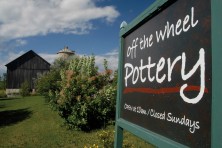Culture Club: The Evolution of Creative Spaces
- Share
- Tweet
- Pin
- Share

Gracing the entrance to Peninsula School of Art is the last of two gray barns that were at one time the entirety of the school. A wealth of stories surrounds the barns and the generations of students who have taken classes in these spaces. The barns have seen things from welding to painting, giant puppets, figure drawing and the “great fire of 2006.”
The two seasonal, barn-like studio buildings were designed in 1964 by Madeline Tripp Tourtelot and her husband, Chicago architect Ned Tourtelot, and they were constructed by local carpenters with Madeline’s guidance. During the summer of 1965, she opened the new studios and art school on County F in Fish Creek.

The Tourtelots designed the barns to be flexible, light-filled spaces. Each had large, wood-framed windows on hinges along the length of the building and additional transom windows above. The windows faced north – optimal for painting – and the courtyard. One barn had more than two hundred individual panes of glass.
Although the studios were designed with adult artists and learners in mind, children were always part of the PenArt community. Ginnie Sowinski, PenArt’s development and events coordinator, recalled, “Growing up almost right next door, as a kid, I would wander over, and Madeline would always make me feel welcome, providing materials and a place to explore.”
When describing the early years of PenArt, historian Jim Legault said:
“There were children’s classes, photography workshops, pottery, jewelry, painting, drawing, sculpture and fabric printing classes … The atmosphere was free, serious, experimental and conducive to getting a lot of work done. There was … the continuous exchange of ideas and information between students, faculty and artists-in-residence.”

Madeline Tripp Tourtelot ran Peninsula School of Art until her retirement in 1971 and donated three acres of land and the two studio barns to the Peninsula Arts Association (PAA) in 1978. Under the direction of student and volunteer Betsy Guenzel – and with the help of Betsy’s husband, Paul, and other members of the PAA’s Art School Committee – Peninsula School of Art became a nonprofit organization and continued to offer seasonal workshops in the gray barns.
In 1995, when Peninsula School of Art expanded and created a year-round campus, the majority of the adult workshop programs moved into the main building, with dedicated studio space for each medium. The children’s programs (Summer Studios for Young Artists) and the occasional adult workshop continued to be held in the seasonal barns.
During the summer of 2006, when a couple that was considering getting married on the PenArt campus stopped by one evening to look at the grounds, they saw smoke coming from one of the barns and called 911. The rags used during an adult encaustic-painting workshop had spontaneously combusted. One barn was a total loss, but the phone call likely prevented the fire from spreading throughout the campus. Needless to say, when that couple had their wedding at PenArt the following year, the rental fee was on us!
The barns did not have air conditioning, screens to keep out the bugs, quality lighting or many of the amenities that today’s students seek, but they have, nonetheless, been a hive of creative activity for more than 50 summers.
So what makes a space a creative space? Really, it’s any space where you give yourself the time and room to create, but for a school such as PenArt in 2019, it means having enough room to allow multiple participants to spread out, display works in progress, safely house and handle equipment, adequately store materials and supplies, and to offer the right kinds of equipment: kid-sized tables, racks for ceramics, printing presses and much more.

For most of our history, our youth programs have run only during the summer, but during the last 10 years, we have seen exponential growth in our public, family and youth programs during the “off season” and now serve more than 3,000 kids and families each year. We need a year-round home for the paint, clay and supplies required to teach these programs and safe spaces for our young artists to explore and learn.
I have come to think of the last gray barn as a “she” – sheltering our campus and protecting our young artists, but she is old and tired. Her siding is rotting; the old wood windows no longer close properly (or stay closed); her concrete floors are cracked; and there is no temperature control to keep the kids cool during the summer months. She’s beyond reasonable investment to repair, and even if we tried, this barn would still be viable for only six months each year.
An artist must continue to grow and evolve; a haven for artists and learners young and old must continue to evolve and support their creative endeavors. So, with the help of current and future donors to the Door to Creativity Campaign, we will be saying good-bye to our faithful guardian – the remaining big, gray barn – during the next 18 months. She will be missed, but she will be replaced by a new, year-round youth-education building that, like her, will welcome and protect the next generation of young artists on our campus.
To learn more about the Door to Creativity Campaign, visit PeninsulaSchoolofArt.org/DTC.
Peninsula Arts and Humanities Alliance, which contributes Culture Club throughout the summer season, is a coalition of nonprofit organizations whose purpose is to enhance, promote and advocate the arts, humanities and natural sciences in Door County.



